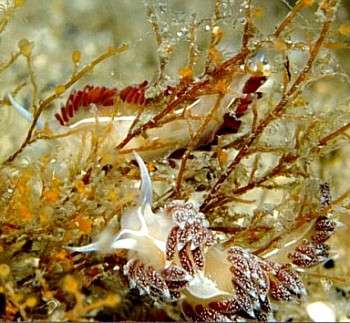
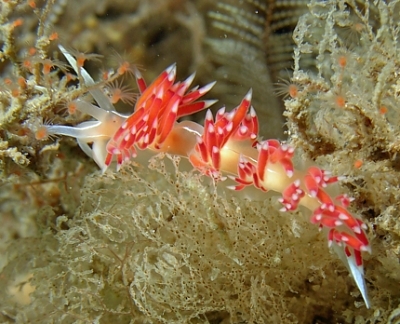
Flabellina verta
(Marcus, 1970)
Order: NUDIBRANCHIA
Suborder: AEOLIDINA
Family: Flabellinidae
DISTRIBUTION
Caribbean and tropical west Atlantic from Cananeia, Brazil to Florida, USA.
PHOTO
Upper: West Palm Beach, Florida, approx 1 inch long, 12 feet of water, 19 March 2000 showing 2 colour variations. Photo: Anne DuPont. Lower: West Palm Beach, 20 feet, Florida, USA, Atlantic, 14 November 2007, Intertidal, strong tidal flow, on orange Eudendrium sp. Length: 1 cm. Photo: Anne DuPont.
Previously on Forum as Flabellina sp. 2.
Animal translucent with the whitish to orange colour of the internal organs showing through the body wall. There is a median white line along the body which splits just in front of the rhinophores with a branch going out along each oral tentacle. There is also a white line along each side of the body just below the cerata running from the base of the oral tentacles to the posterior tip of the foot. The cerata have a white tip, and in some animals the ceratal wall is scattered with small opaque white spots. The digestive gland ranges in colour from dark reddish brown to red or orange. There is a distinct brim around the notal edge and the slender tapering rhinophores are smooth. The cerata are arranged in clusters along each side off the notum with one precardiac cluster on each side and 4-6 postcardiac clusters.
This relatively small species, growing to approximately 12 mm in length was first described from Cananeia, Brazil. It was described as having smooth rhinophores and the cerata arranged in about 6 groups down each side. In colour they were described as "whitish with opaque transverse bands on the rhinophores. and longitudinal lines on the [oral] tentacles which unite forming a triangle between the rhinophores. There are some white spots on the cerata ..."
Anne DuPont [message #2199] and Millen & Hamann (2006) show some variability in the colour pattern, particularly concerning the presence of white spots on the cerata, the extent of the white lines on the body and the colour of the cerata digestive gland.
-
Marcus, E. (1970) On some opisthobranchs from Cananeia, Brazil. Boletim da Faculdade de Filosofia, Ciencias e Letras. Universidade de Sao Paulo, Zoologia 27: 207-228 .
-
Millen, S. V. & Hamann, J.C. (2006) A New Nudibranch Species, Genus Flabellina (Opisthobranchia: Aeolidacea) from the Caribbean with redescriptions of F. verta (Marcus 1970), and F. dushia (Marcus and Marcus, 1963). Proceedings of the California Academy of Sciences 57: 925-936.
Rudman, W.B., 2007 (November 23) Flabellina verta (Marcus, 1970). [In] Sea Slug Forum. Australian Museum, Sydney. Available from http://www.seaslugforum.net/find/flabvert
Related messages
Flabellina verta feeding
November 24, 2007
From: Anne DuPont
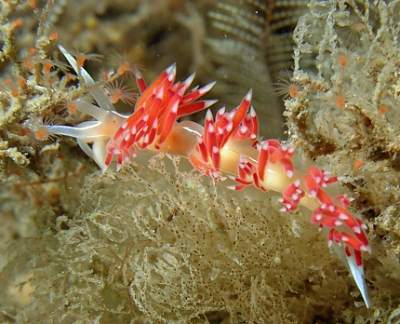
Hello Bill,
I photographed this Flabellina verta feeding this week in West Palm Beach, FL. We have F verta, F dushia and F dana in our area and it is difficult to tell them apart.
Locality: West Palm Beach, 20 feet, Florida, USA, Atlantic, 14 November 2007, Intertidal, strong tidal flow. Length: 1 cm. Photographer: Anne DuPont.
I sent the photos to Sandra Millen (Dept. Zoology, U.B.C.) to confirm its identification. She confirmed it is F. verta and said:
"I can see that F. verta is eating an orange Eudendrium sp. which is very similar to the one eaten by F. vansyoci on the Pacific coast of Mexico."
Sandra's 2006 paper:
"A New Nudibranch Species, Genus Flabellina (Opisthobranchia: Aeolidacea) from the Caribbean with Redescriptions of F. verta (Marcus 1970), and F. dushia (Marcus and Marcus, 1963)"
can be found at her website: http://www.zoology.ubc.ca/person/millen
Thank you for the wonderful forum and all your time.
Cordially,
Anne DuPont
Delray Beach, FL
akdupont@bellsouth.net
DuPont, A., 2007 (Nov 24) Flabellina verta feeding. [Message in] Sea Slug Forum. Australian Museum, Sydney. Available from http://www.seaslugforum.net/find/21156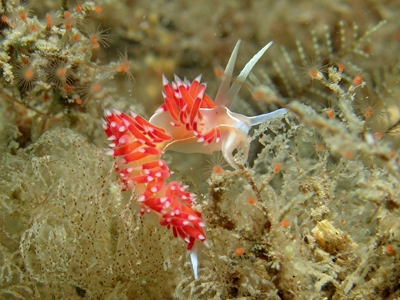
Dear Anne,
Thanks very much for these nice photos. It gives me the impetus to rename your Flabellina sp. 2 which Sandra Millen & Jeff Hamann have identified with F. verta. I am not an expert on hydroids, but if you have these three species occurring quite commonly it might be nice to see if they are all on the same species of hydroid or whether they all have their own different species. Some aeolids seem to be very restricted in their food choice while others are much less choosey.
If by chance you have photos of F. dana it would be nice to include that on the Forum as well
Best wishes,
Bill Rudman
Flabellina from Florida
April 5, 2000
From: Anne DuPont

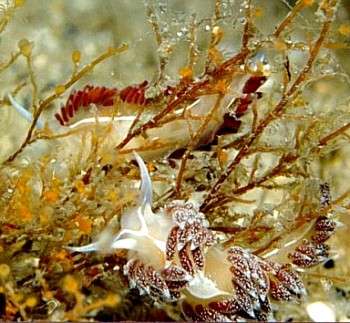
Hello Bill,
How are things at the museum?
On March 5, 2000, West Palm Beach, Florida, in about 12 feet of water, I photographed these two nudibranchs (size about 1 inch)
together on a night dive. I photographed them together again on March 19 (lower photo).
I did not know if it was (1) a romantic encounter to mating, (2) a fight or (3) someone is having lunch! I also could not identify them.
I sent the photos to Sandra Millen at UBC and her comments are:
" The animal in the background with smooth rhinophores, red cerata and three white lines is typical of an undescribed
Flabellina found in Florida, the Gulf of Mexico and the Caribbean. The animal in the foreground may be a color variety or a different species altogether." (Sandra Millen, UBC)
Do you know who they are? Or what their behavior indicates?
Thank you.
Cordially,
Anne DuPont
PS: Sandra gave me permission to use her comments.
adupont@gate.net
Anne DuPont, 2000 (Apr 5) Flabellina from Florida. [Message in] Sea Slug Forum. Australian Museum, Sydney. Available from http://www.seaslugforum.net/find/2199Note added 24 November 2007: This has been identified as Flabellina verta.
Thanks Anne & Sandra.
Both animals seem to have the same white lines so perhaps they are just colour forms of one species. It's a pity we don't have more information on living Flabellina engeli Marcus, 1968 [Curacao, Colombia, Florida (Marcus 1977)] and Coryphella dushia Marcus, 1963 [Curacao] which were both described from preserved material. They seem to be the only two flabellinids reported from the Caribbean.
On what they are doing? I suspect the attraction is the hydroid colony they are on, which through close proximity will almost certainly lead to mating if they are the same species. If you look at the top photo, I have highlighted a spot at the bottom of the photo where you can see an egg string, typical of a flabellinid. I suspect this has been produced by some of your animals. When aeolids find a source of their food they usually stay there feeding, mating and laying eggs until they die or they eat the colony out.
Best wishes,
Bill Rudman.
